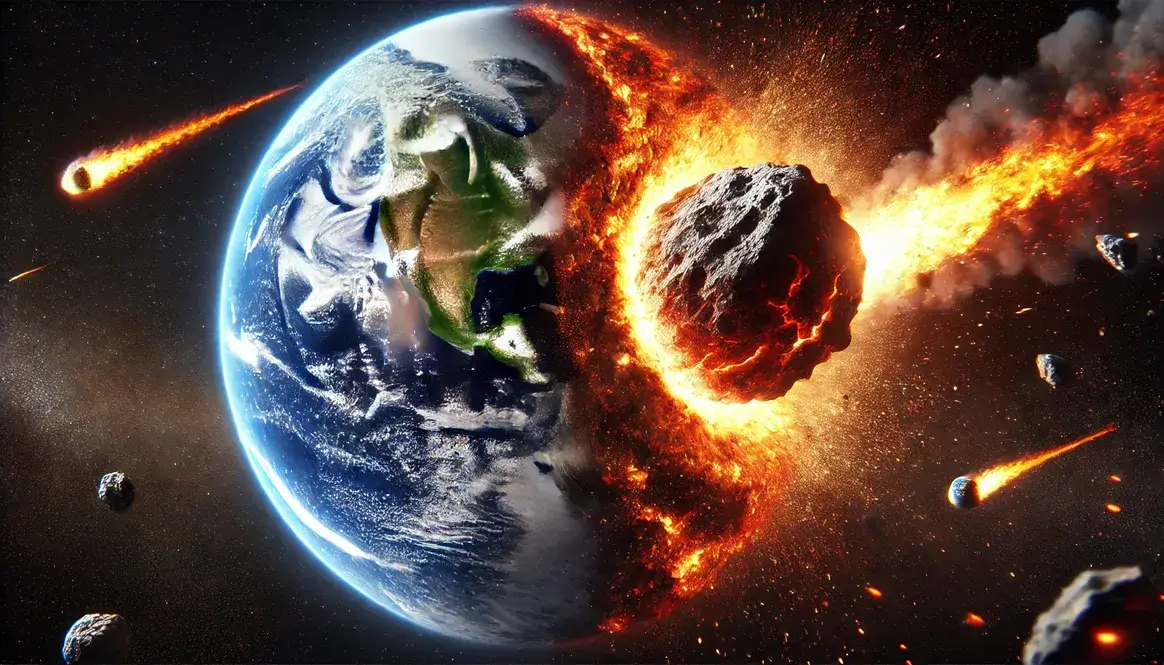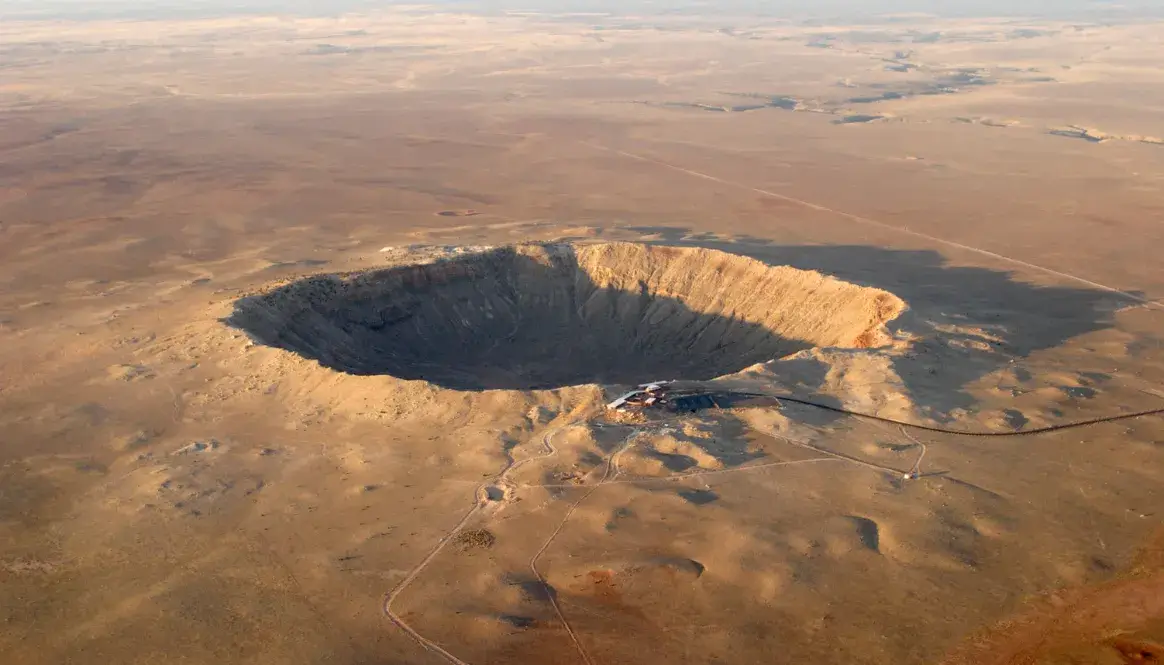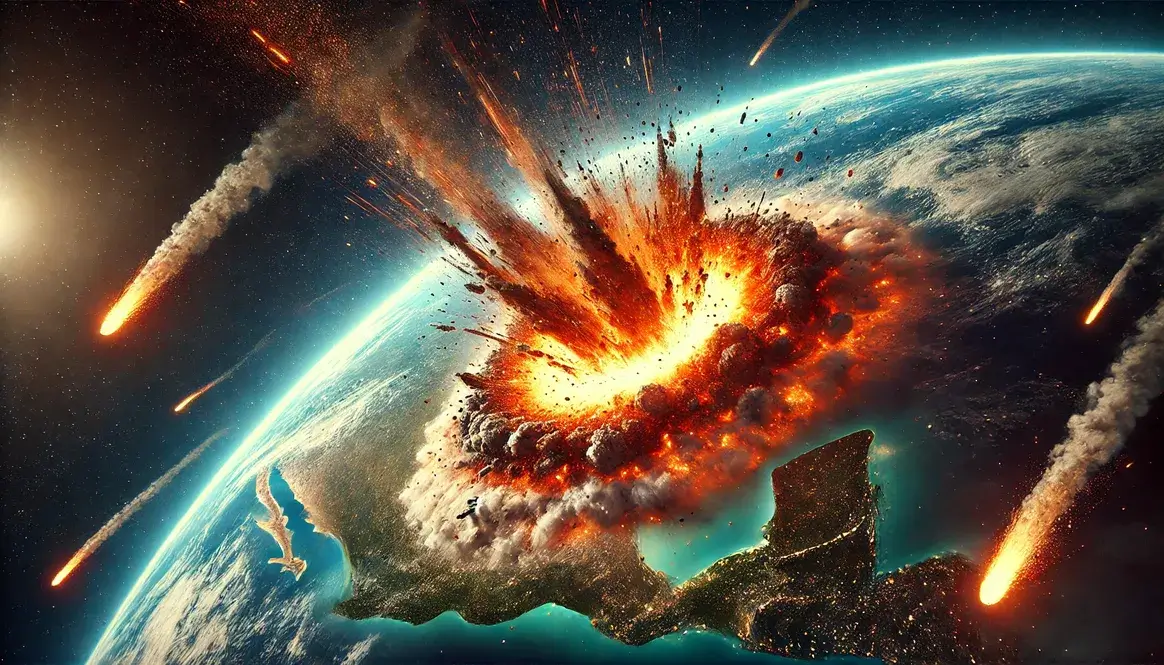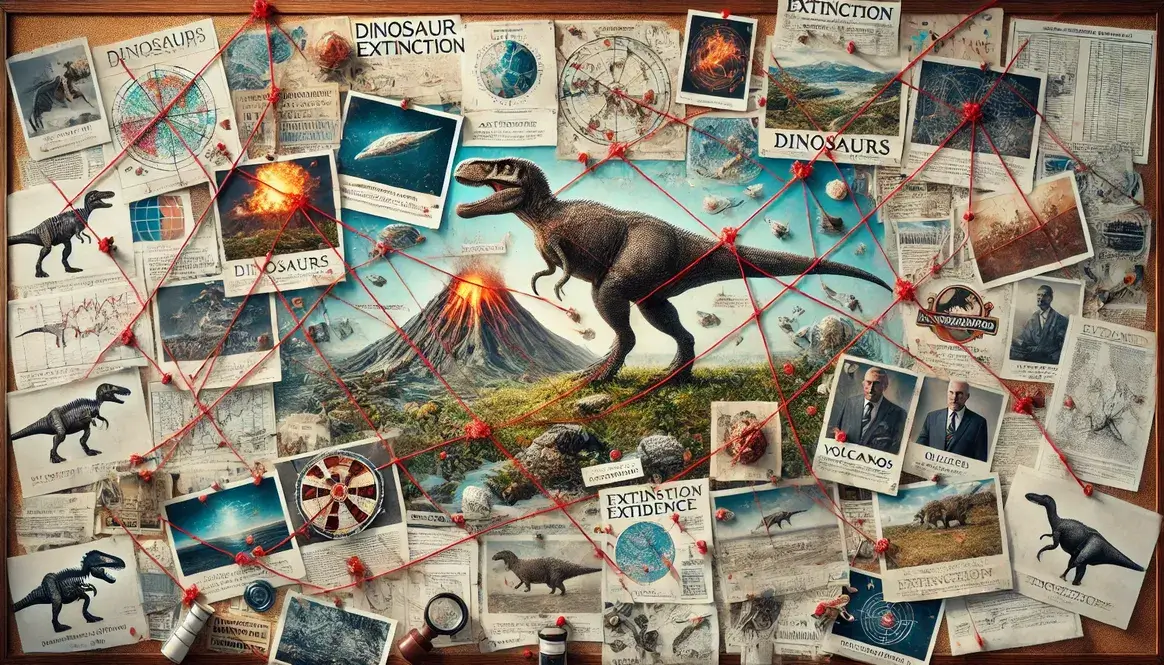66 million years ago, a massive asteroid slammed into Earth, forever changing the course of life on our planet. This cosmic collision, known as the Chicxulub impact, not only spelled doom for the dinosaurs but also sparked a series of catastrophic events, including widespread fires that engulfed much of the globe.
As the asteroid plunged into what is now the Yucatan Peninsula in Mexico, it released an enormous amount of energy – equivalent to billions of atomic bombs. This cataclysmic event marked the beginning of a fiery ordeal that would reshape Earth’s ecosystems and contribute to one of the most significant mass extinctions in our planet’s history.
Fires after dinosaur asteroid: The initial blaze
The moment the asteroid struck, it set off a chain reaction of fire-starting events. The impact itself generated intense heat, capable of igniting anything combustible in its immediate vicinity. But the fiery aftermath wasn’t limited to the impact site – it spread rapidly across the globe.
The initial fire outbreaks were vast and intense. Scientists estimate that within hours of the impact, fires had started on nearly every continent. These weren’t just isolated incidents – entire regions were transformed into infernos.
The first wave of fires likely lasted for several days to weeks, varying in intensity and duration depending on local conditions. Some areas may have burned for months, fueled by abundant vegetation and fanned by impact-induced weather changes.
Heat pulse from the impact
One of the primary ways the asteroid impact triggered fires was through a phenomenon called the “heat pulse.” When the asteroid hit Earth, it created a massive fireball that sent a pulse of intense heat radiating outward.
This thermal radiation was so powerful that it could ignite fires thousands of miles away from the impact site. Here’s a breakdown of how the heat pulse affected different distances from the impact:
| Distance from impact | Effect of heat pulse |
|---|---|
| 0-1,000 km | Instant ignition of all combustible materials |
| 1,000-5,000 km | Severe burning, widespread fires |
| 5,000-10,000 km | Ignition of dry materials, localized fires |
| >10,000 km | Potential for fires in highly combustible areas |
This heat pulse was brief but incredibly intense, capable of setting alight forests, grasslands, and even the feathers of unfortunate animals caught in its path.
Debris-sparked flames
While the heat pulse was responsible for the initial wave of fires, another fire-starting mechanism soon followed: the rain of superheated debris ejected from the impact site.
When the asteroid hit, it vaporized rock and sent a plume of hot material high into the atmosphere. As this debris fell back to Earth, it heated up again due to friction with the atmosphere. The result was a rain of glowing, red-hot particles falling across vast swathes of the planet.
These particles, some as small as grains of sand and others as large as boulders, acted like millions of tiny matches, starting new fires wherever they landed. The geographic spread of these debris-sparked flames was even more extensive than the initial heat pulse, reaching areas that had escaped the first wave of fires.
- Areas most affected by debris-sparked fires:
- Regions within a few thousand kilometers of the impact site
- Coastal areas and islands (due to less atmospheric protection)
- Dry, fire-prone ecosystems
The combination of the heat pulse and debris-sparked flames created a truly global fire event, unlike anything seen before or since in Earth’s history. This fiery cataclysm set the stage for the dramatic changes that would follow, reshaping life on Earth for millions of years to come.
Learn more about the Chicxulub impact and its immediate effects.
The firestorm phase: Merging infernos
As the initial blazes spread across the globe, a new and even more terrifying phase of the fires after the dinosaur asteroid began: the firestorm phase. Individual fires, fueled by abundant vegetation and driven by impact-induced winds, started to merge into massive, unstoppable infernos.
These mega-fires, known as firestorms, were unlike any wildfires we see today. They created their own weather systems, with temperatures so high that they could melt rock and vaporize water. The intensity of these firestorms was truly apocalyptic, reaching temperatures of over 1,000°C (1,832°F) in some areas.
The duration of the firestorm phase varied across different regions, but in many areas, it lasted for weeks or even months. The powerful Chicxulub impact had set in motion a chain of events that would keep the fires burning long after the initial blaze.
Fuel for the flames
The fires that raged across the planet had no shortage of fuel. Different types of vegetation contributed to the intensity and spread of the fires:
- Forests: Dense woodlands provided ample fuel, with both living trees and dead underbrush feeding the flames.
- Grasslands: Vast prairies, once home to grazing dinosaurs, became rapid corridors for fire spread.
- Swamps and peatlands: These waterlogged ecosystems, usually resistant to fire, dried out due to the impact’s heat and became unexpected tinderboxes.
The impact on various ecosystems was devastating and far-reaching:
- Tropical rainforests: Once lush and diverse, many were reduced to ash, leading to long-term changes in global climate patterns.
- Temperate forests: These regions experienced widespread burning, with some areas taking centuries to recover.
- Tundra: Even these normally fire-resistant ecosystems weren’t spared, as the extreme heat dried out normally frozen ground.
The global nature of these fires meant that few ecosystems escaped unscathed, setting the stage for the massive extinction event that followed.
Fire-generated weather
As if the fires themselves weren’t destructive enough, they began to create their own terrifying weather phenomena. The intense heat from the firestorms caused rapid air movement, leading to the formation of fire-induced storms and tornadoes.
Fire tornadoes, also known as fire whirls, are vortexes of flame that can reach heights of hundreds of meters. These deadly spirals of fire and wind could spread flames at incredible speeds, jumping fire breaks and natural barriers that might have otherwise contained the blaze.
The firestorms also generated massive pyrocumulonimbus clouds – thunderclouds formed by intense heat and rising smoke. These clouds produced their own lightning, which in turn ignited new fires, creating a devastating feedback loop.
| Fire-generated phenomenon | Description | Impact on fire spread |
|---|---|---|
| Fire tornadoes | Spinning vortexes of flame | Rapid, unpredictable fire spread |
| Pyrocumulonimbus clouds | Fire-generated thunderclouds | Lightning ignites new fires |
| Fire-induced winds | Strong winds caused by temperature differences | Carries embers long distances, starting spot fires |
These fire-generated weather events not only spread the fires further but also made them nearly impossible to extinguish naturally. The resulting chaos reshaped landscapes and ecosystems, contributing significantly to the mass extinction debate that continues to intrigue scientists today.
Smoke and ash: Choking the atmosphere
The fires after the dinosaur asteroid didn’t just change the landscape – they transformed the very air our planet’s inhabitants breathed. As forests, grasslands, and other ecosystems burned, they released enormous quantities of smoke and ash into the atmosphere. This wasn’t your typical campfire smoke; it was a thick, toxic cloud that wrapped around the globe.
The smoke contained a mix of gases and particulates:
- Carbon dioxide and carbon monoxide
- Soot and ash particles
- Various toxic compounds from burning organic matter
This atmospheric cocktail had immediate and drastic effects on global climate. The dark particles in the smoke absorbed sunlight, warming the upper atmosphere while cooling the surface below. This temperature inversion created a stable layer of air that trapped pollutants close to the ground, worsening air quality for surviving organisms.
In the short term, global temperatures plummeted. The post-impact climate change was rapid and severe, with some estimates suggesting temperature drops of 20-30°C in some regions. This sudden cooling would have been a shock to ecosystems already reeling from fire damage.
Blocking out the sun
Perhaps the most devastating effect of the smoke and ash was its impact on sunlight. The thick layer of particulates in the atmosphere acted like a global sunscreen, significantly reducing the amount of solar radiation reaching Earth’s surface.
This reduction in sunlight had catastrophic consequences for plant life:
- Photosynthesis slowed or stopped entirely in many areas.
- Plants that survived the fires now faced starvation due to lack of light.
- Decay of dead vegetation released more carbon dioxide, further altering atmospheric composition.
The collapse of plant life had a domino effect on the food chain. Herbivores, already struggling with habitat loss from the fires, now faced widespread food shortages. This, in turn, impacted carnivores, leading to a cascading collapse of ecosystems worldwide.
The duration of this “impact winter” is still debated among scientists, but most agree it lasted at least several years, possibly even decades. During this time, the Earth was a cold, dark place, inhospitable to many forms of life that had thrived in the warm Cretaceous period.
Recent studies suggest that while the thickest smoke might have cleared within a few years, fine ash particles could have remained in the upper atmosphere for decades, continuing to influence global climate. This prolonged period of altered conditions likely played a crucial role in the mass extinction event that followed the impact.
The atmospheric changes caused by the fires and impact debris created a perfect storm of environmental stressors. Combined with other factors like impact-induced tsunamis and acidification of the oceans, these conditions made survival a monumental challenge for many species, setting the stage for the dramatic shifts in Earth’s biodiversity that would follow.
The slow burn: Lingering fires and their effects
After the initial firestorm phase, the world didn’t simply return to normal. The fires after the dinosaur asteroid continued to smolder and burn in many areas, creating a “slow burn” phase that lasted for months or even years. These persistent fires, while less intense than the initial inferno, played a crucial role in shaping the post-impact world.
In some regions, particularly those with thick layers of organic material like peat bogs or coal seams, fires could burn underground for extended periods. These subterranean fires would occasionally break through to the surface, reigniting above-ground blazes and maintaining a cycle of destruction.
The long-term effects of these lingering fires were profound:
- Soil sterilization: Prolonged exposure to heat killed beneficial microorganisms in the soil.
- Erosion: Loss of vegetation led to increased soil erosion, altering landscapes.
- Habitat fragmentation: Patchy burn patterns created isolated ecological islands.
- Delayed recovery: Ongoing fires hindered the regrowth of vegetation.
These changes to landscapes and ecosystems had lasting impacts on the survival and evolution of species. The altered environments favored organisms that could adapt quickly to new conditions, setting the stage for the rise of new dominant species in the post-dinosaur world.
Charcoal evidence in the fossil record
The fires that raged across the planet left behind a telltale signature in the geological record: charcoal. This ancient charcoal, also known as fossil charcoal or fusinite, provides valuable insights into the extent and intensity of the post-impact fires.
Scientists studying these ancient fire events use several techniques:
- Microscopic analysis: Examining thin sections of rock under microscopes to identify charcoal particles.
- Chemical analysis: Measuring carbon isotopes to distinguish between different types of organic matter.
- Stratigraphic mapping: Tracing charcoal layers across wide areas to understand fire extent.
The charcoal evidence tells a compelling story. Researchers have found a global layer of soot and charcoal precisely at the Cretaceous-Paleogene (K-Pg) boundary, the geological marker of the extinction event. This layer, sometimes referred to as the “fireball layer,” contains a mix of impact debris and fire-derived particles.
What does this evidence tell us about the fires?
- Global extent: Charcoal has been found at K-Pg boundary sites worldwide, confirming the global nature of the fires.
- Intensity: The structure of the charcoal indicates extremely high-temperature fires.
- Duration: Varying thickness of charcoal layers suggests different burn durations in different areas.
By studying this charcoal evidence alongside other geological markers, scientists can reconstruct a timeline of events following the impact. This helps in understanding how the fires interacted with other extinction mechanisms, such as impact-induced air pollution, to shape the course of life on Earth.
The study of ancient fire events isn’t just about understanding the past. It also provides valuable insights into how modern ecosystems might respond to large-scale fires and rapid climate change, offering lessons for our warming world.
Fires and extinction: Role in the dinosaurs’ demise
The fires after the dinosaur asteroid played a significant part in the mass extinction event that marked the end of the Cretaceous period. While the impact itself was devastating, the subsequent global firestorm magnified the destruction, pushing many species past the point of no return.
These fires contributed to the extinction process in several ways:
- Direct mortality: Many animals and plants were killed outright by the flames and heat.
- Habitat destruction: Vast areas of forest and grassland were incinerated, leaving little shelter or food.
- Atmospheric changes: Smoke and ash blocked sunlight, disrupting photosynthesis and food chains.
- Long-term environmental alterations: Burned landscapes took years or decades to recover.
The groups most affected by the fires were those least able to escape or endure prolonged environmental stress. Large terrestrial animals, including most dinosaurs, were particularly vulnerable. Their size, which had been an advantage for millions of years, now worked against them in a world where food was scarce and habitats were fragmented.
Plants, the foundation of terrestrial ecosystems, were hit hard. Many species couldn’t survive the combination of burning, climate change, and lack of sunlight. The loss of plant diversity had a cascading effect up the food chain, contributing to the collapse of complex ecosystems.
| Group | Impact of fires |
|---|---|
| Large dinosaurs | High mortality due to habitat loss and food scarcity |
| Small mammals | Some survived in burrows or by entering dormant states |
| Birds | Many species extinct, but some survived, possibly due to flight ability |
| Insects | Mixed impact, with some groups devastated and others surviving |
| Marine life | Indirect effects through ecosystem changes and ocean acidification |
The fires, combined with other impact effects, created a “perfect storm” of extinction pressures. This explains why the K-Pg extinction was so severe, affecting a wide range of species across different habitats.
Survivors in a scorched world
Despite the apocalyptic conditions, some organisms managed to survive the fiery aftermath of the impact. These survivors shared certain characteristics that gave them an edge in the harsh post-impact world:
- Small size: Smaller animals required less food and could hide in protected microhabitats.
- Burrowing ability: Underground dwellers were shielded from the worst of the fires and temperature extremes.
- Dietary flexibility: Omnivores and generalists could adapt to limited food sources.
- Dormancy capabilities: Some organisms could enter states of dormancy, waiting out the worst conditions.
Plants that survived often had adaptations like:
- Underground storage organs (tubers, bulbs)
- Tough, fire-resistant bark
- Seeds that required fire for germination
The fires shaped post-impact evolution in profound ways. The survivors of extinction became the ancestors of many modern species. For example, the ability of some mammals to burrow and enter torpor likely contributed to their survival and subsequent diversification.
In the plant world, fire-adapted species gained an advantage. This may have influenced the spread of flowering plants (angiosperms) in the post-extinction world, as many have fire-resistant or fire-dependent reproductive strategies.
The post-fire landscape, with its patchy distribution of resources, likely favored animals that could move between isolated areas of suitable habitat. This might have contributed to the evolution of improved locomotion in some lineages.
In essence, the fires after the dinosaur asteroid acted as a powerful selective force, shaping the trajectory of life on Earth for millions of years to come. The organisms that survived this fiery crucible became the foundation of the diverse ecosystems we see today.
Learning from the ashes: Modern implications
The fires that followed the dinosaur-killing asteroid offer more than just a glimpse into Earth’s dramatic past. They provide valuable lessons about global catastrophes and their long-lasting effects on our planet’s ecosystems. By studying these ancient infernos, scientists gain insights that are surprisingly relevant to our modern world.
One key takeaway is the interconnectedness of Earth’s systems. The K-Pg fires weren’t isolated events; they were part of a complex chain reaction that affected the atmosphere, climate, and biosphere. This holistic view of planetary processes is crucial for understanding and addressing current environmental challenges.
Here are some specific lessons we can draw from the K-Pg fires:
- Tipping points: The rapid spread of fires after the impact shows how quickly Earth’s systems can reach critical thresholds, leading to cascading effects.
- Recovery times: The long-lasting impact of the fires reminds us that ecosystems can take centuries or even millennia to fully recover from major disturbances.
- Unexpected consequences: The fire-induced weather phenomena demonstrate how large-scale events can produce surprising and amplifying effects.
- Importance of diversity: The varied survival rates among different species highlight the value of biodiversity in ecosystem resilience.
These lessons have direct relevance to current climate change and wildfire issues. As our planet warms, we’re seeing an increase in the frequency and intensity of wildfires worldwide. While not on the same scale as the K-Pg event, these fires are altering landscapes, affecting air quality, and contributing to climate feedback loops.
The impact on ecosystems we observe in the K-Pg record provides a sobering preview of what continued global warming might bring. Just as the post-impact fires reshaped the Earth’s biosphere, today’s changing climate is forcing rapid adaptations and migrations among plant and animal species.
Moreover, the study of the K-Pg fires underscores the importance of atmospheric chemistry in global climate. The smoke and aerosols from these ancient fires altered Earth’s climate for years. Similarly, today’s wildfires release large amounts of carbon dioxide and particulates, contributing to both short-term air quality issues and long-term climate change.
On a more positive note, understanding how life recovered after the K-Pg fires gives us hope for ecosystem resilience. It shows that even after catastrophic events, life finds a way to rebound and diversify. This knowledge can inform conservation efforts and ecosystem restoration projects in fire-affected areas today.
In conclusion, the fires after the dinosaur asteroid serve as a stark reminder of our planet’s vulnerability to sudden, large-scale changes. By heeding the lessons written in ash and charcoal from 66 million years ago, we can better prepare for and mitigate the environmental challenges of our own time. The past, it turns out, is key to understanding our present and safeguarding our future.









